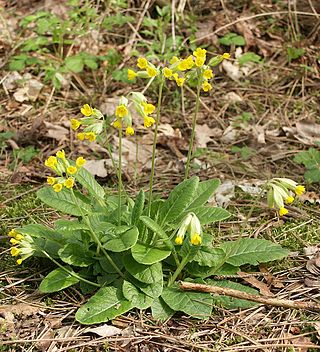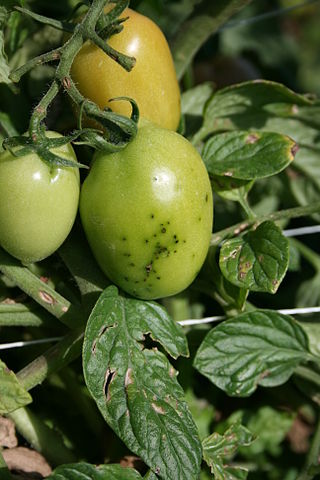
Primula is a genus of herbaceous flowering plants in the family Primulaceae. They include the primrose, a familiar wildflower of banks and verges. Other common species are P. auricula (auricula), P. veris (cowslip), and P. elatior (oxlip). These species and many others are valued for their ornamental flowers. They have been extensively cultivated and hybridised. Primula are native to the temperate Northern Hemisphere, south into tropical mountains in Ethiopia, Indonesia, and New Guinea, and in temperate southern South America. Almost half of the known species are from the Himalayas.

The Primulaceae, commonly known as the primrose family, are a family of herbaceous and woody flowering plants including some favourite garden plants and wildflowers. Most are perennial though some species, such as scarlet pimpernel, are annuals.

Primula veris, the cowslip, common cowslip, or cowslip primrose, is a herbaceous perennial flowering plant in the primrose family Primulaceae. The species is native throughout most of temperate Europe and western Asia, and although absent from more northerly areas including much of northwest Scotland, it reappears in northernmost Sutherland and Orkney and in Scandinavia. This species frequently hybridizes with other Primulas such as the common primrose Primula vulgaris to form false oxlip which is often confused with true oxlip, a much rarer plant.

Primula vulgaris, the common primrose, is a species of flowering plant in the family Primulaceae, native to Eurasia. The common name is primrose, or occasionally common primrose or English primrose to distinguish it from other Primula species referred to as primroses.
In botany, an umbel is an inflorescence that consists of a number of short flower stalks that spread from a common point, somewhat like umbrella ribs. The word was coined in botanical usage in the 1590s, from Latin umbella "parasol, sunshade". The arrangement can vary from being flat-topped to almost spherical. Umbels can be simple or compound. The secondary umbels of compound umbels are known as umbellules or umbellets. A small umbel is called an umbellule. The arrangement of the inflorescence in umbels is referred to as umbellate, or occasionally subumbellate.

Primula elatior, the oxlip, is a species of flowering plant in the family Primulaceae, native to nutrient-poor and calcium-rich damp woods and meadows throughout Europe, with northern borders in Denmark and southern parts of Sweden, eastwards to the Altai Mountains and on the Kola Peninsula in Russia, and westwards in the British Isles.

Primula scotica, commonly known as Scottish primrose, is a species of flowering plant in the family, Primulaceae, the primroses and their relatives. It was first described by James Smith, and is endemic to the north coast of Scotland.

Barrington Hill Meadows is a 16.1 hectare biological Site of Special Scientific Interest in Somerset, England, notified in 1987.

"Pseudomonas tomato" is a Gram-negative plant pathogenic bacterium that infects a variety of plants. It was once considered a pathovar of Pseudomonas syringae, but following DNA-relatedness studies, it was recognized as a separate species and several other former P. syringae pathovars were incorporated into it. Since no official name has yet been given, it is referred to by the epithet 'Pseudomonas tomato' .

The flora of Romania comprises around 3,450 species of vascular plants, which represents around 30% of the vascular flora of Europe.

Ramularia is a genus of ascomycete fungi. Its species, which are anamorphs of the genus Mycosphaerella, are plant pathogens. Economically important host species include Narcissus, sugar beet, and barley.

Monochroa servella is a moth of the family Gelechiidae. It is found from Fennoscandia to Italy and from Portugal to Bulgaria and Russia.

Riccardin C is a macrocyclic bis(bibenzyl). It is a secondary metabolite isolated from the Siberian cowslip subspecies Primula veris subsp. macrocalyx, in Reboulia hemisphaerica and in the Chinese liverwort Plagiochasma intermedium.

Falseuncaria ruficiliana, the red-fringed conch, is a species of moth of the family Tortricidae. It is found in China (Xinjiang) and most of Europe. The habitat consists of limestone, heathland and moorland.
Ramularia vallisumbrosae is a fungal plant pathogen infecting daffodils (Narcissus), causing narcissus white mould disease.

Distyly is a type of heterostyly in which a plant demonstrates reciprocal herkogamy. This breeding system is characterized by two separate flower morphs, where individual plants produce flowers that either have long styles and short stamens, or that have short styles and long stamens. However, distyly can refer to any plant that shows some degree of self-incompatibility and has two morphs if at least one of the following characteristics is true; there is a difference in style length, filament length, pollen size or shape, or the surface of the stigma. Specifically these plants exhibit intra-morph self-incompatibility, flowers of the same style morph are incompatible. Distylous species that do not exhibit true self-incompatibility generally show a bias towards inter-morph crosses - meaning they exhibit higher success rates when reproducing with an individual of the opposite morph.

Ramularia ulmariae is a fungal species described by Cooke in 1876. Ramularia ulmariae belongs to the genus Ramularia and the family Mycosphaerellaceae. No subspecies are listed in the Catalog of Life.

Primula × polyantha, the polyanthus primrose or false oxlip, is a naturally occurring hybrid species of flowering plant in the family Primulaceae. It is the result of crosses between Primula veris and Primula vulgaris. It is native to Europe, found where the parent species' ranges overlap, and many artificial hybrid cultivars have also been created for the garden trade. Naturally‑occurring individuals tend to have yellow flowers, while a wide range of flower colors has been developed in the cultivars over the centuries.

Chromatomyia primulae is a species of leaf-mining fly in the family Agromyzidae, of the order Diptera. The larvae mine the leaves of Primula species. The fly was described by the French physician and entomologist, Jean-Baptiste Robineau-Desvoidy in 1851 and is found in Europe.

Urocystis primulae is a fungal plant pathogen that infects several species of Primula.
















